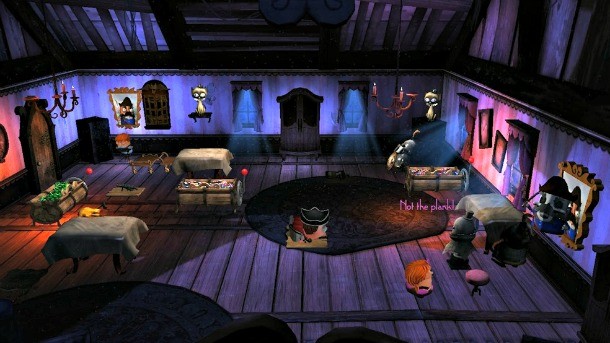Our extra-large special edition is here. Subscribe today and receive the 25% longer issue at no extra cost!
Wayward Manor Review

The first game from The Odd Gentleman was The Misadventures of P.B. Winterbottom, a unique puzzle/platformer with time-bending mechanics and a silent film motif that won the studio a fair amount of critical acclaim. Now, the studio has teamed up with Neil Gaiman – the award winning writer behind The Sandman comic series and novels such as Stardust and American Gods – to create a new puzzle game about a ghost who terrorizes the inhabitants of a house. When Wayward Manor was announced, my interest was piqued. Unfortunately, the final product is such a messy and unpredictable experience that I felt haunted by the ghost of disappointment.
Set in the 1920s, the tale begins when the eccentric Budds family moves into an old Victorian estate. Unfortunately, the mansion itself has grown fond of being abandoned, and wants the Budds to move back out. Players take on the role of a disembodied specter who bullies the Budds until they run screaming from their new house. Gaiman’s narration is told from the point of view of the house, and while the writer’s macabre, poetic prose stands on par with much of his work, the story itself it not compelling. Plus, with so little dialogue, Gaiman probably could have written the entire game over a lunch break. The story never gives us a complete look at any member of the Budds family, so you never understand what makes them tick or what really frightens them, and the plot never motivates you to kick them out of their own home.
Unfortunately, Wayward Manor’s weak narrative is actually its strongest element, because the gameplay is even worse. As a ghost, you float above each room and possess certain objects – opening windows or knocking bottles off shelves in order to scare each room’s inhabitant to the breaking point. As you terrorize the Budds, your ghostly powers become more potent, and you’re able to interact with more objects in each room. In theory, this concept sounds ripe for unique puzzle challenges. In practice, Wayward Manor is a confusing and repetitive experience that often left me wondering what to do.
One of Wayward Manor’s biggest problems is that few of its puzzles are really clever enough to be called puzzles. Most of the time you’re turning on old timey record players or opening windows so gusts of wind push objects across a room. Many of these tasks are repeated over and over ad nauseam throughout each level – I can’t even tell you how many bottles I knocked off rafters and onto people’s heads.
Even when Wayward Manor’s puzzles are more involved, they don’t make sense. At one point in the game, I possessed the mounted head of a lion, causing it to roar and startle grandpa Budds, who in turn fired his crossbow at the beast. However, I didn’t earn any fright points for doing this until I turned several tiki figurines scattered around the room and redirected the arrow through a candle so that it lit the mounted lion head on fire. Fortunately, there is no risk of failing any of Wayward Manor’s levels, since broken bottles and other important objects in the environment often respawn. You’re free to click on every object in the environment until you hit the lucky combo that frightens whoever happens to be in the room at that time – effectively removing any need for strategic thinking.
The saddest part about Wayward Manor is that I know that The Odd Gentlemen made a great game; I kept asking myself, “Is this really the same studio that made The Misadventures of P.B. Winterbottom?” At one point, I actually shut down the game because I thought maybe I’d booted up the wrong title by mistake. My time with Wayward Manor felt more like a trial than a macabre puzzle adventure about a haunted house. Wayward Manor isn’t frightening, but it sure scared me away.

















Get the Game Informer Print Edition!
Explore your favorite games in premium print format, delivered to your door.
- 10 issues per year
- Only $4.80 per issue
- Full digital magazine archive access
- Since 1991









